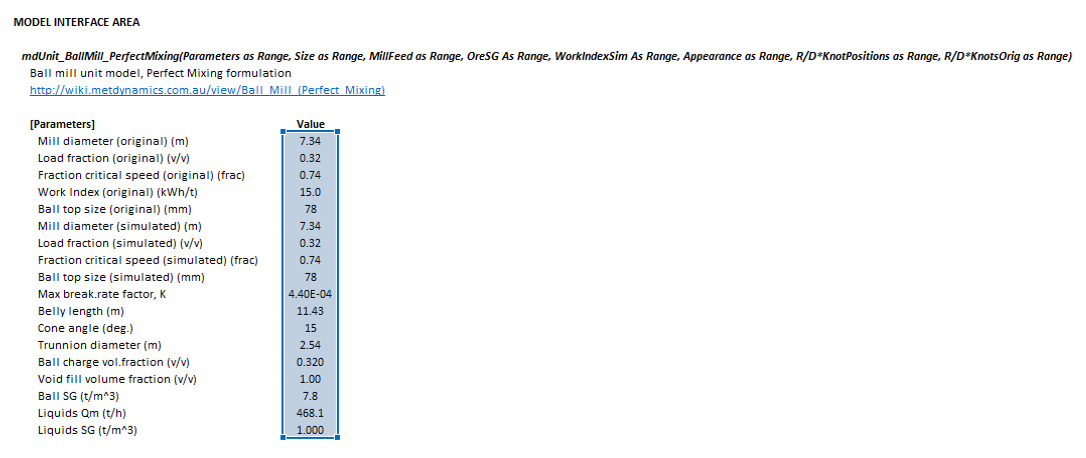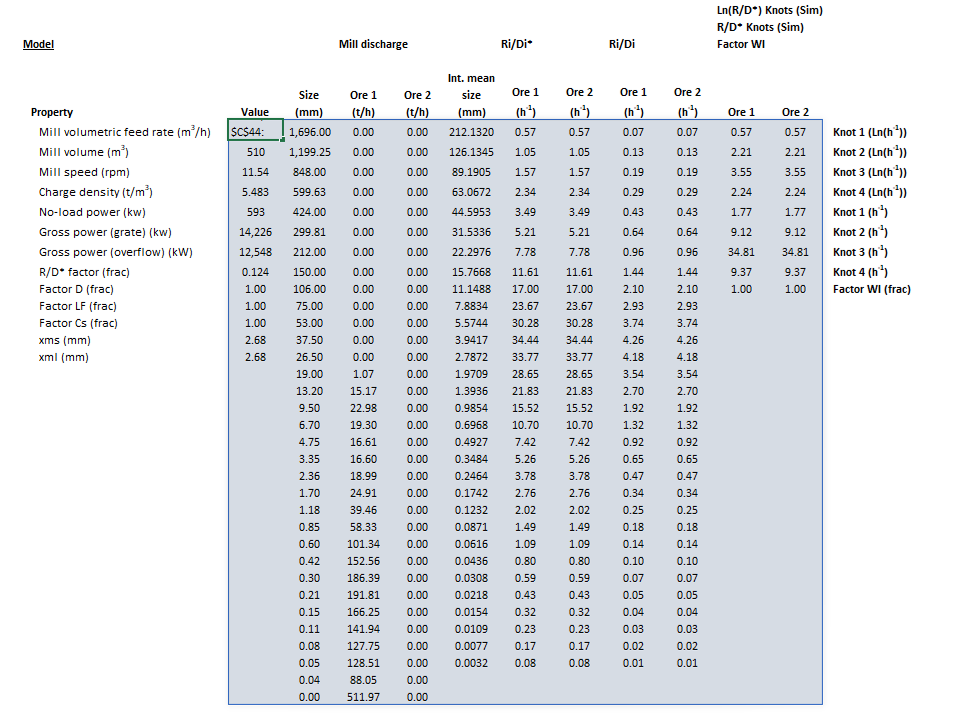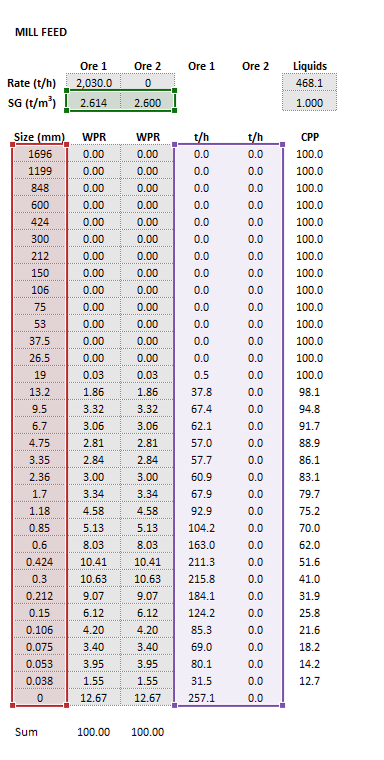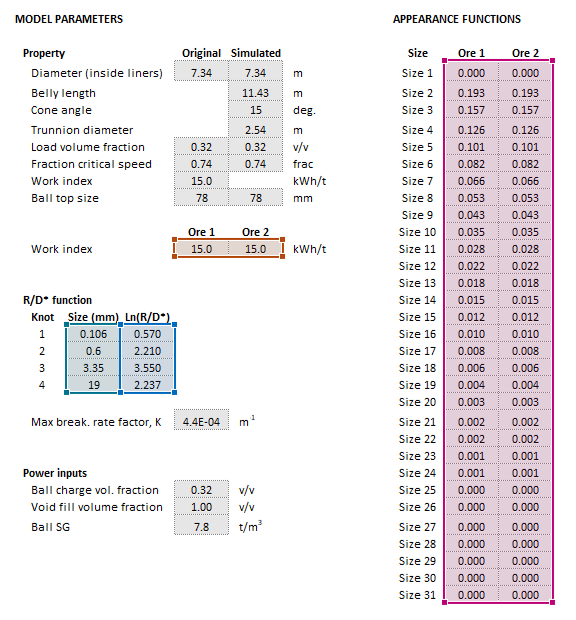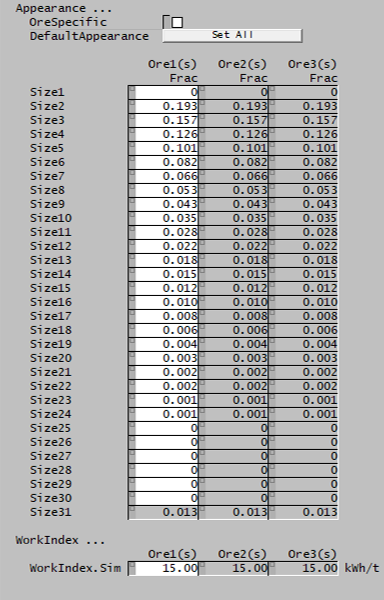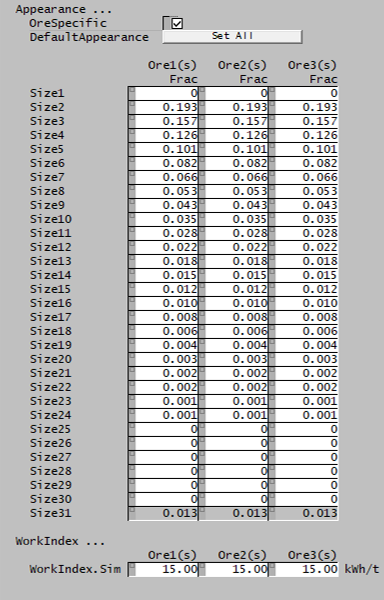Ball Mill (Perfect Mixing)
Description
This is an implementation of the Whiten Perfect Mixing ball mill model described by Napier-Munn et al.[1]
The model described here is for steady-state simulation. For dynamic simulation, see Ball Mill (Perfect Mixing, Dynamic).
Model Theory
The Perfect Mixing model is based on a population balance of particles entering the mill, breaking into smaller sizes, and discharging as product. For a mill operating in steady-state, the following diagram represents the balance for a given size fraction:
The steady-state population balance is formulated mathematically as:
where:
- is the mass feed rate of solids in size interval
- is the mass product rate of solids in size interval
- is the mass of solids in the mill load in size interval
- is the breakage rate of solids in the mill load in size interval
- is the rate of discharge from the mill of solids in size interval
- is the Appearance function, the distribution of particle mass arising from the breakage of a parent particle in size interval into progeny of size interval
As the mill is perfectly mixed, the product is defined by the mill contents and discharge rate as:
Noting also that
leads to
and
The mill product can therefore be computed provided a feed rate, Appearance function and breakage rate per discharge rate, , is available. Alternatively, the function can be determined from the feed rate, product rate and Appearance function.
Discharge rate
The discharge rate, , is related to the residence time of pulp in the mill and can be corrected for different volumetric feed rates and mill volumes by first normalising to
where:
- is the residence time normalised discharge rate per size interval
- is the volumetric flow rate of pulp in mill feed (solids plus liquids)
- is the mill diameter (inside liners)
- is the mill length
The actual discharge rate for a given mill and pulp feed rate is subsequently scaled as
with becoming for mill model calibration and simulation.
Breakage rate
The rate is a function of particle size and is typically a smooth, concave downward curve with a maximum related to ball size. In order to reduce the number of model parameters, the rates are specified only at three or four regularly spaced sizes (knots). Cubic spline interpolation is then used to reconstruct the complete set of rates for all size intervals.
The breakage rate, , is affected by mill operating conditions and the rate is further scaled by the following relation:
The scaling factors are defined as:
where:
- is mill diameter
- is load fraction, the load volume as a fraction of mill volume
- is the fraction critical speed of the mill
- is the Bond ball work index of the ore
- is the ball diameter
- is the maximum breakage rate factor which relates ball size and the size at which is maximum, i.e.
and the subscript refers to the original mill from which was derived and refers to the mill being simulated (scaled).
The grouping of breakage rate scaling factors above, excluding work index, essentially represent a relationship with mill power draw, as noted by Napier-Munn et al., King and others.[1][2]
Appearance function
The Appearance function describes the mass-by-size distribution of progeny particles resulting from the breakage of parent particles.
The Appearance function may be specified for a particular ore. Alternatively, the default Broadbent-Callcott appearance function may be used, which is defined as:[3]
where is the breakage product particle size and is the original particle size.
Internal mesh series
The Perfect Mixing ball mill model is formulated internally with a geometric progression of mesh sizes at intervals. Feed and product size fractions are automatically converted to and from the internal mesh series during model computation. The size intervals allow the Appearance function to be specified as a one-dimensional matrix, rather than the two dimensional form defined above, since
when the intervals are so spaced.
Power draw
The Whiten Perfect Mixing mill model formulation does not explicitly include a relationship with mill power draw, other than the breakage rate scaling observations noted above.
However, a simple estimate of power draw is provided for user convenience. Power is calculated according to Morrell's empirical approach for grate and overflow mills.[4]
Multi-component modelling
The original Whiten Perfect Mixing model formulation only considered the properties of a single ore type.
This model internally applies different Appearance functions and breakage rate scaling to separate population balance computations for each ore type in the feed, as conceptually suggested by Napier-Munn et al.[1]
Dynamic modelling
- Main article: Ball Mill (Perfect Mixing, Dynamic)
Excel
The Perfect Mixing ball mill model may be invoked from the Excel Formula Bar with the following function call:
=mdUnit_BallMill_PerfectMixing(Parameters as Range, Size as Range, MillFeed as Range, OreSG As Range, WorkIndexSim As Range, Appearance as Range, R/D*KnotPositions as Range, R/D*KnotsOrig as Range)
Invoking the function with no arguments will print Help text associated with the model.
Inputs
The required inputs are defined below in matrix notation with elements corresponding to cells in Excel row () x column () format:
where:
- is the number of size intervals
- is the number of ore types
- is the number of breakage rate per discharge rate knots
- is the size of the square mesh interval that feed mass is retained on (mm)
- , i.e. descending size order from top size () to sub mesh ( mm)
- is feed mass flow rate (t/h)
- is Specific Gravity or density (- or t/m3)
- is the Appearance function value, the fraction of parent particle mass appearing in size interval (frac)
- is breakage rate per discharge rate normalised for residence time (h-1/h-1/h)
Results
The results are displayed in Excel as an array corresponding to the matrix notation below:
where is product mass flow rate (t/h), is the size of the geometric mean size of the internal mesh series interval that mass is retained on (mm), and all other variables are as defined previously.
Example
The images below show the selection of input arrays and output results in the Excel interface.
SysCAD
The SysCAD interface for steady-state (ProBal) mode is described below. For SysCAD Dynamic, see Ball Mill (Perfect Mixing, Dynamic).
ScdMD*BallMill page
The first tab page in the access window will have this name.
| Tag (Long/Short) | Input / Display | Description/Calculated Variables/Options |
|---|---|---|
| Tag | Display | This name tag may be modified with the change tag option. |
| Condition | Display | OK if no errors/warnings, otherwise lists errors/warnings. |
| ConditionCount | Display | The current number of errors/warnings. If condition is OK, returns 0. |
| GeneralDescription / GenDesc | Display | This is an automatically generated description for the unit. If the user has entered text in the 'EqpDesc' field on the Info tab (see below), this will be displayed here.
If this field is blank, then SysCAD will display the unit class ID. |
| Requirements | ||
| On | CheckBox | This enables the unit. If this box is not checked, then the material will pass straight through the mill with no change to the size distribution. |
| Method | Perfect Mixing | The Whiten Perfect Mixing model is used to determine the mill product size distribution. Different parameters can be used for different solids.. |
| Herbst-Fuerstenau | The Herbst-Fuerstenau model is used to determine the mill product size distribution. Different parameters can be used for different solids.. See Mill (Herbst-Fuerstenau). | |
| Options | ||
| ShowQFeed | CheckBox | QFeed and associated tab pages (eg Sp) will become visible, showing the properties of the combined feed stream. |
| ShowQProd | CheckBox | QProd and associated tab pages (eg Sp) will become visible, showing the properties of the products. |
| PowerModels | CheckBox | Show alternative tumbling mill power model calculations on the Power page. |
| MediaTrajectory | CheckBox | Show mill media rolling, sliding and free flight trajectory computations on the MediaTraj page. |
| OverfillingIndicator | CheckBox | Show overflow ball mill slurry volume, residence time, and overfilling evaluation on Overfilling page. |
| SizeForPassingFracCalc | Input (global) | Size fraction for % Passing calculation. The size fraction input here will be shown in the Stream Summary section. |
| FracForPassingSizeCalc | Input (global) | Fraction passing for Size calculation. The fraction input here will be shown in the Stream Summary section. |
| Stream Summary | ||
| MassFlow / Qm | Display | The total mass flow in each stream. |
| SolidMassFlow / SQm | Display | The Solids mass flow in each stream. |
| LiquidMassFlow / LQm | Display | The Liquid mass flow in each stream. |
| VolFlow / Qv | Display | The total Volume flow in each stream. |
| Temperature / T | Display | The Temperature of each stream. |
| Density / Rho | Display | The Density of each stream. |
| SolidFrac / Sf | Display | The Solid Fraction in each stream. |
| LiquidFrac / Lf | Display | The Liquid Fraction in each stream. |
| Passing | Display | The mass fraction passing the user-specified size (in the field SizeForPassingFracCalc) in each stream. |
| Passes | Display | The user-specified (in the field FracForPassesSizeCalc) fraction of material in each stream will pass this size fraction. |
Mill page
The Mill page is used to specify the input parameters for the mill model.
| Tag (Long/Short) | Input / Display | Description/Calculated Variables/Options |
|---|---|---|
| Requirements | ||
| NumParallelUnits | Input | The number of parallel, identical units to simulate. Feed is divided by the number of parallel units before being sent to the unit model. Unit model product is multiplied back by the same value and returned to the SysCAD product stream. All unit model result values are shown per parallel unit. |
| Scaling | ||
| Diameter | Input | The inside liner diameter of the original and simulated ball mills. |
| BellyLength | Input | The inside liner belly length of the simulated ball mill, excluding cones. |
| ConeAngle | Input | Angle of the feed and discharge end cones, measured as positive displacement from the vertical direction. |
| Diameter | Input | The inside liner trunnion diameter of the simulated ball mill. |
| LoadFrac | Input | The volumetric load fraction of the original and simulated ball mills. |
| FracCS | Input | The fraction critical speed of the original and simulated ball mills. |
| WorkIndex | Input | Bond Ball Work Index of ore in the original mill. |
| BallTopSize | Input | Diameter of new balls added to the original and simulated ball mills. |
| MaxBreakageRateFactor / K | Input | Parameter relating ball size and the size at which the breakage rate per discharge rate is maximum. |
| R/DFunction | ||
| NumSplineKnots | Input | Number of spline knots for the function. |
| Size | Input | Spline knot size positions. |
| Ln(R/D*) | Input | Values of at each spline knot position. |
| Power | ||
| BallVolume | Input | Volumetric fraction of mill occupied by balls and voids. |
| VoidFillFraction | Input | Volumetric fraction of void space between balls occupied by slurry. |
| BallSG | Input | Specific Gravity or density of ball media. |
| Results | ||
| MillVolume | Display | Volume inside mill, including cones. |
| MillSpeed | Display | Rotational speed of simulated mill. |
| ChargeDensity | Display | Density of charge in simulated mill, including balls, solids and liquids. |
| NoLoadPower | Display | Power draw of empty mill (no balls, solids or liquids) |
| GrossPower.Grate | Display | Gross power draw of mill in grate configuration |
| GrossPower.Overflow | Display | Gross power draw of mill in overflow configuration |
Ore page
This page is used to define the comminution properties of SysCAD species with the size distribution quality in the project.
| Tag (Long/Short) | Input / Display | Description/Calculated Variables/Options |
|---|---|---|
| Distribution | ||
| Name | Display | Shows the name of the SysCAD Size Distribution (PSD) quality associated with the feed stream. |
| IntervalCount | Display | Shows the number of size intervals in the SysCAD Size Distribution (PSD) quality associated with the feed stream. |
| SpWithPSDCount | Display | Shows the number of species in the feed stream assigned with the SysCAD Size Distribution (PSD) quality. |
| Appearance | ||
| OreSpecific | CheckBox | Ore-specific parameters, allows the Appearance data to be separately input for all species. Default is all species have the same set of single input properties. |
| DefaultAppearance | Sets all species to the the default Broadbent-Callcott Appearance function. | |
| Appearance | Input | User-specified Appearance function data for all species with size distribution property. |
| WorkIndex | ||
| WorkIndex.Sim | Input | Bond Ball Work Index data for all species with size distribution property. |
Ri/Di page
This page displays the scaling factors and breakage rate per discharge rate for each size interval computed by the Perfect Mixing model.
| Tag (Long/Short) | Input / Display | Description/Calculated Variables/Options |
|---|---|---|
| Scaling | ||
| RDStar/RD | Display | Value of the factor for discharge rate scaling. |
| Diameter | Display | Value of the mill diameter factor for rate scaling. |
| LoadFraction | Display | Value of the load fraction factor for rate scaling. |
| FracCS | Display | Value of the fraction critical speed factor for rate scaling. |
| WorkIndex | Display | Valuex of the Work Index factor of each ore species for rate scaling. |
| Ri/DiStar | ||
| Size | Display | Size of each interval in internal mesh series. |
| MeanSize | Display | Geometric mean size of each interval in internal mesh series. |
| Ri/DiStar | Display | Value of normalised rate for each size interval, for each ore species. |
| Ri/Di | ||
| Size | Display | Size of each interval in internal mesh series. |
| MeanSize | Display | Geometric mean size of each interval in internal mesh series. |
| Ri/DiStar | Display | Value of rate for each size interval, for each ore species. |
Power page
This optional page displays the inputs and results for alternative tumbling mill power models. The page is only visible if PowerModels is selected on the Scd*BallMill page.
- Main article: Tumbling Mill (Power)
| Tag (Long/Short) | Input / Display | Description/Calculated Variables/Options |
|---|---|---|
| Power | ||
| HoggFuerstenau | CheckBox | Shows inputs and results for tumbling mill power calculations using the Hogg & Fuerstenau method. See Tumbling Mill (Power)#Hogg & Fuerstenau |
| MorrellE | CheckBox | Shows inputs and results for tumbling mill power calculations using the Morrell Empirical method. See Tumbling Mill (Power)#Morrell Empirical |
| MorrellC | CheckBox | Shows inputs and results for tumbling mill power calculations using the Morrell Continuum method. See Tumbling Mill (Power)#Morrell Continuum |
| MorrellD | CheckBox | Shows inputs and results for tumbling mill power calculations using the Morrell Discrete Shell method. See Tumbling Mill (Power)#Morrell Discrete Shell |
MediaTraj page
This page displays the inputs and results for tumbling mill media trajectory calculations. The page is only visible if MediaTraj is selected on the Scd*BallMill page.
- Main article: Tumbling Mill (Media Trajectory)
Overfilling page
This page displays the inputs and results for mill overfilling calculations. The page is only visible if Overfilling is selected on the Scd*BallMill page.
- Main article: Ball Mill (Overfilling)
About page
This page is provides product and licensing information about the Met Dynamics Models SysCAD Add-On.
| Tag (Long/Short) | Input / Display | Description/Calculated Variables/Options |
|---|---|---|
| About | ||
| HelpLink | Opens a link to the Installation and Licensing page using the system default web browser. Note: Internet access is required. | |
| Information | Copies Product and License information to the Windows clipboard. | |
| Product | ||
| Name | Display | Met Dynamics software product name |
| Version | Display | Met Dynamics software product version number. |
| BuildDate | Display | Build date and time of the Met Dynamics Models SysCAD Add-On. |
| License | ||
| File | This is used to locate a Met Dynamics software license file. | |
| Location | Display | Type of Met Dynamics software license or file name and path of license file. |
| SiteCode | Display | Unique machine identifier for license authorisation. |
| ReqdAuth | Display | Authorisation level required, MD-SysCAD Full or MD-SysCAD Runtime. |
| Status | Display | License status, LICENSE_OK indicates a valid license, other messages report licensing errors. |
| IssuedTo | Display | Only visible if Met Dynamics license file is used. Name of organisation/seat the license is authorised to. |
| ExpiryDate | Display | Only visible if Met Dynamics license file is used. License expiry date. |
| DaysLeft | Display | Only visible if Met Dynamics license file is used. Days left before the license expires. |
References
- ↑ 1.0 1.1 1.2 Napier-Munn, T.J., Morrell, S., Morrison, R.D. and Kojovic, T., 1996. Mineral comminution circuits: their operation and optimisation.
- ↑ King, R.P., 2012. Modeling and Simulation of Mineral Processing Systems. Elsevier.
- ↑ Gupta, A. and Yan, D.S., 2016. Mineral processing design and operations: an introduction. Elsevier.
- ↑ Morrell, S., 1996. Power draw of wet tumbling mills and its relationship to charge dynamics. Pt. 2: an empirical approach to modelling of mill power draw. Transactions of the Institution of Mining and Metallurgy. Section C. Mineral Processing and Extractive Metallurgy, 105.





















































